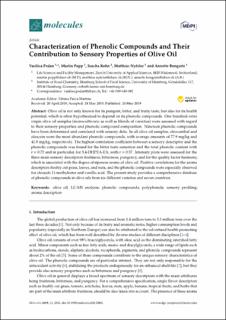Bitte benutzen Sie diese Kennung, um auf die Ressource zu verweisen:
https://doi.org/10.21256/zhaw-5536| Publikationstyp: | Beitrag in wissenschaftlicher Zeitschrift |
| Art der Begutachtung: | Peer review (Publikation) |
| Titel: | Characterization of phenolic compounds and their contribution to sensory properties of olive oil |
| Autor/-in: | Pedan, Vasilisa Popp, Martin Rohn, Sascha Nyfeler, Matthias Bongartz, Annette |
| et. al: | No |
| DOI: | 10.3390/molecules24112041 10.21256/zhaw-5536 |
| Erschienen in: | Molecules |
| Band(Heft): | 24 |
| Heft: | 11 |
| Seite(n): | 2041 |
| Erscheinungsdatum: | 2019 |
| Verlag / Hrsg. Institution: | MDPI |
| ISSN: | 1420-3049 1433-1373 |
| Sprache: | Englisch |
| Schlagwörter: | Olive oil; LC-MS analysis; Phenolic compound; Polyphenol; Sensory profiling; Aroma description |
| Fachgebiet (DDC): | 664: Lebensmitteltechnologie |
| Zusammenfassung: | Olive oil is not only known for its pungent, bitter, and fruity taste, but also for its health potential, which is often hypothesized to depend on its phenolic compounds. One hundred extra virgin olive oil samples (monocultivaric as well as blends of varieties) were assessed with regard to their sensory properties and phenolic compound composition. Nineteen phenolic compounds have been determined and correlated with sensory data. In all olive oil samples, oleocanthal and oleacein were the most abundant phenolic compounds, with average amounts of 77.9 mg/kg and 41.8 mg/kg, respectively. The highest correlation coefficient between a sensory descriptor and the phenolic compounds was found for the bitter taste sensation and the total phenolic content with r = 0.72 and in particular, for 3,4-DHPEA-EA, with r = 0.57. Intensity plots were assessed for the three main sensory descriptors fruitiness, bitterness, pungency, and for the quality factor harmony, which is associated with the degree of ripeness aroma of olive oil. Positive correlations for the aroma descriptors freshly cut grass, leaves, and nuts, and the phenolic compounds were especially observed for oleoside 11-methylester and vanillic acid. The present study provides a comprehensive database of phenolic compounds in olive oils from six different varieties and seven countries. |
| URI: | https://digitalcollection.zhaw.ch/handle/11475/17504 |
| Volltext Version: | Publizierte Version |
| Lizenz (gemäss Verlagsvertrag): | CC BY 4.0: Namensnennung 4.0 International |
| Departement: | Life Sciences und Facility Management |
| Organisationseinheit: | Institut für Lebensmittel- und Getränkeinnovation (ILGI) Institut für Computational Life Sciences (ICLS) |
| Enthalten in den Sammlungen: | Publikationen Life Sciences und Facility Management |
Dateien zu dieser Ressource:
| Datei | Beschreibung | Größe | Format | |
|---|---|---|---|---|
| 2019_Pedan_Characterization_of_phenolic_compounds.pdf | 2.1 MB | Adobe PDF |  Öffnen/Anzeigen |
Zur Langanzeige
Pedan, V., Popp, M., Rohn, S., Nyfeler, M., & Bongartz, A. (2019). Characterization of phenolic compounds and their contribution to sensory properties of olive oil. Molecules, 24(11), 2041. https://doi.org/10.3390/molecules24112041
Pedan, V. et al. (2019) ‘Characterization of phenolic compounds and their contribution to sensory properties of olive oil’, Molecules, 24(11), p. 2041. Available at: https://doi.org/10.3390/molecules24112041.
V. Pedan, M. Popp, S. Rohn, M. Nyfeler, and A. Bongartz, “Characterization of phenolic compounds and their contribution to sensory properties of olive oil,” Molecules, vol. 24, no. 11, p. 2041, 2019, doi: 10.3390/molecules24112041.
PEDAN, Vasilisa, Martin POPP, Sascha ROHN, Matthias NYFELER und Annette BONGARTZ, 2019. Characterization of phenolic compounds and their contribution to sensory properties of olive oil. Molecules. 2019. Bd. 24, Nr. 11, S. 2041. DOI 10.3390/molecules24112041
Pedan, Vasilisa, Martin Popp, Sascha Rohn, Matthias Nyfeler, and Annette Bongartz. 2019. “Characterization of Phenolic Compounds and Their Contribution to Sensory Properties of Olive Oil.” Molecules 24 (11): 2041. https://doi.org/10.3390/molecules24112041.
Pedan, Vasilisa, et al. “Characterization of Phenolic Compounds and Their Contribution to Sensory Properties of Olive Oil.” Molecules, vol. 24, no. 11, 2019, p. 2041, https://doi.org/10.3390/molecules24112041.
Alle Ressourcen in diesem Repository sind urheberrechtlich geschützt, soweit nicht anderweitig angezeigt.